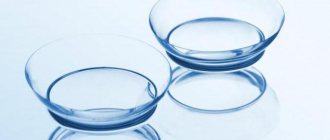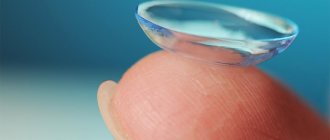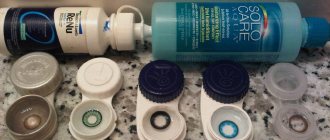Advantages of disposable polymer products
In addition to lenses that can be worn for several months, optics may also offer you one-day options.
These are ultra-thin products that do not require special care. You simply open a new package in the morning, insert the lens and see clearly again. They are indispensable for trips, hikes and other situations in the absence of the necessary hygienic conditions. When using them, the risk of eye infections is significantly reduced. After all, it is poor-quality cleaning of lenses, their use for more than 12-15 hours a day, non-compliance with wearing periods that become the causes of inflammatory eye diseases: conjunctivitis, keratitis and others.
The likelihood of developing diseases increases due to the fact that bacteria accumulate on the surface of the lens. Knowing all these nuances, everyone can answer the question of whether it is possible to wear daily lenses longer. But many believe that these are just tricks of marketers aimed at increasing the profits of companies that produce such goods.
How long can you wear contact lenses?
The manufacturing company indicates on the packaging how long you can wear the lenses it has produced. The duration is determined primarily by the material from which they are made. That is, the duration of wearing is not a whim of the manufacturer, it is determined by objective reasons depending on the characteristics of the material.
Over-wearing lenses and insufficient care lead to irritation and infectious diseases of the eyes
Modern technologies make it possible to produce lenses that can be worn without removal for several days or even weeks. However, experts are confident that one-day products are the safest for health. In one day, the amount of sediment that can become a serious threat to health does not have time to accumulate on their surface. In addition, they are easy to use and do not require special care - in the evening you simply throw away the lenses and put on new ones in the morning.
Classic hydrogel lenses are designed for approximately 12-14 hours of wear, but for many similar products the duration of wear can be even shorter - from 6-8 hours. It is recommended to sleep in them for no more than two hours, but experts recommend not to abuse this.
Find your nearest optical store
Silicone hydrogel lenses can be left on during short sleep. You don’t even have to take them off at night, but it’s better to limit yourself to one such night, and then still put them in a container with a solution, where they will be cleaned, and in the meantime your eyes will rest.
If you experience discomfort in your lenses before their expiration date, contact your ophthalmologist immediately.
A number of manufacturers also produce lenses designed for long-term wear. For example, for a week. Moreover, PureVision 2, Biofinity and AirOptix Night&Day lenses are on sale, which can be left in place for a month. But:
- they can be used only after consultation with an ophthalmologist to exclude the presence of contraindications to wearing lenses of this category;
- nevertheless, it is advisable to periodically remove them for washing and so that the eyes can rest;
- if discomfort occurs, you should use moisturizing drops to avoid dry eyes;
- It is necessary to visit an ophthalmologist every six months in order to promptly detect changes and complications that may arise when wearing lenses in this mode.
And, of course, after the specified period of use has expired, they will definitely need to be replaced with a new pair. If the deadline has not yet expired, but you experience discomfort, remove the lenses and consult an ophthalmologist
.
Purpose of daily lenses
Everyone knows whether it is possible to violate the operating conditions of the product, which are specified in the instructions.
This is not recommended. But nevertheless, people with vision problems constantly wonder whether it is possible to wear daily lenses for more than one day. Of course, no one can prohibit doing this. But no one will guarantee eye comfort and safety either. The main purpose of daily disposable lenses is to minimize contact with surrounding bacteria. They are in sterile packaging and are handled only once.
In addition, when using them, people no longer need to buy special containers, solutions, or fermented tablets. Simply having a new package on hand is enough. By the way, they are suitable even for those people who were forced to give up regular lenses due to a reaction to solutions for cleaning them.
What happens if you wear daily contact lenses for longer than a day?
You're probably wondering if you can wear daily lenses for several days. Unfortunately, many people do this. Some even go to bed without taking them off. However, failure to follow recommendations for the proper use of disposable lenses is fraught with complications. Among them:
- oxygen starvation of the membranes of the eye;
- decreased circulation of tear fluid;
- inflammatory diseases (keratitis, conjunctivitis, etc.);
- impossibility of removing corneal tissue metabolic products from under the lens.
Therefore, do not be lazy to remove and throw away a pair before going to bed.
To select suitable daily contact lenses, consult your ophthalmologist. He will test your vision, select lenses and tell you how to use them. You can take advantage of the Bausch & Lomb certificate and get your first pair of lenses for free.
Terms of use
Wanting to understand whether it is possible to wear daily lenses more, you need to figure out how to use them. Only if you follow all the rules of use can you count on your eyes remaining healthy.
Manufacturers indicate that re-wearing daily lenses is not allowed. After all, they are made using a special technology that ensures a high level of hydration throughout the day. During this time, protein deposits do not have time to form on them.
Before opening the package and removing the lens from it, you must wash your hands thoroughly. You should also not use fatty creams, oils, or lotions before this procedure. The package must be opened by pulling up the special tab on the front side. After this, you need to inspect the lens; there should be no visible damage to it. After making sure that everything is in order, you can insert it into the eye. In the evening, with clean, washed hands, remove the lens and throw it away.
Why can't it be used multiple times?
You can often hear statements that daily lenses do not have to be thrown away every evening. There are people who wear them day after day for a couple of weeks or wear them for 2 days or longer without taking them off. We will try to give reliable information about why you shouldn’t do this .
Silicone hydrogel, from which one-day contact correction products are made, is a soft and plastic material. It contains a high percentage of water, so it has the properties of a sponge. Proteins and fats, which are always present in the tear fluid of our eyes, quickly adhere to the hydrogel.
ARTICLES ON THE TOPIC:
- Do you want to learn how to put on contact lenses quickly and easily? And what will happen if...
- Tips on which contact lenses are best to choose for vision correction, among...
- Why is it dangerous to wear lenses for more than the prescribed period and what will happen if you still violate...
Daily contact lenses cannot be cleaned overnight in solutions like routine replacement.
If you wear the same lenses several times in a row, a hydrogel full of protein deposits will get into your eye. Its surface is rough, although it is not noticeable to the eye. It causes discomfort to the cornea. The person will experience dryness, presence of a foreign body in the eyes, headache and pain in the eye, especially when looking at the light. In the future, infections and complications from the cornea .
Who are disposable lenses recommended for?
In many countries around the world, people prefer one-day options.
After all, their use does not cause any discomfort. People who have used long-term wear lenses know that over time, even with proper care, they begin to feel in the eye and cause discomfort. Some of them even become cloudy. If you don't find out whether you can wear daily lenses longer and use them according to the manufacturer's instructions, you won't encounter these problems. There are certain categories of people who are recommended to wear only disposable products. These include those who are forced to stay in unfavorable conditions for a long time: in air-conditioned rooms, in smoky areas. They are also recommended for people suffering from diabetes.
If you know about your hypersensitivity to pollen, solutions and other substances that are intended to care for lenses, then it is better to opt for disposable options.
What are lenses?
A contact lens is a small product of a soft or hard structure that has optical properties and is designed to increase visual acuity.
Typically, the lens has a “bowl” shape that is placed on the eyeball. The inner surface of the lens follows the shape of the cornea of the eye, and the outer side of the lens helps to correct the optical system of the eye.
Contact lenses are used to correct vision diseases such as myopia, farsightedness, and astigmatism. Thanks to an invention such as contact lenses, the image of objects perceived by the eye is focused clearly on the retina without distortion of shape and proportions, as happens, for example, when wearing glasses. Vision correction with contact lenses has a wider range than spectacle or surgical vision correction. In addition, unlike glasses, lenses are less dangerous and provide a larger viewing radius, which is quite important for car drivers.
For the first time, contact lenses were made from organic glass. Lenses made of this material were absolutely uncomfortable to wear, created the sensation of a foreign body in the eye and had very low oxygen permeability. These days, lenses are made from polymers. They come in hydrogel and silicone hydrogel.
Hydrogel contact lenses
In modern times, contact lenses are usually made from transparent polymer materials. In 1960, hydroxyethyl methacrylate (HEMA) lenses began to be produced. These lenses are called hydrogel lenses.
The advantage of this polymer material is that it is hydrophilic and can absorb up to 38% of water, making it very soft and elastic.
Contact hydrogel lenses supply the eye with oxygen quite well and do not create obstacles to the flow of tear fluid into the inner part of the lens.
In order to improve the quality of hydrogel lenses, research and new developments are constantly being carried out to increase the hydrophilicity of the HEMA material and the technology of pouring soft contact lenses.
Hydrogel lenses have both advantages and disadvantages. Among the advantages are:
- low price;
- ease of lens selection and replacement.
Disadvantages of hydrogel lenses:
- Only daily wearing of contact lenses;
- low gas permeability of lenses, as a result of which hypoxia and redness of the eyes may develop when wearing lenses in enclosed spaces.
Silicone hydrogel lenses
This generation of soft contact lenses appeared a little later than hydrogel lenses. They contain a combination of polymers - hydrogel and silicone. Unlike hydrogel contact lenses, silicone hydrogel lenses are more comfortable to wear and safer. The advantage of silicone in lenses is that it has such a quality as hydrophobicity, that is, it already contains a certain amount of water.
Silicone hydrogel lenses are the best option for everyday use. Due to the presence of silicone in the chemical composition of the lens, oxygen permeability increases, so these lenses can be worn continuously (up to 7 days).
The advantages of silicone hydrogel contact lenses are as follows:
- increased oxygen permeability;
- Possibility of prolonged wearing of lenses;
- no feeling of dryness and discomfort while wearing lenses;
- increased density of the material, thanks to which the lenses hold their shape better;
- preventing the accumulation of protein and lipid deposits on lenses;
- simplicity and ease of handling lenses;
- the ability to sleep in lenses without harm to the eyes;
- maintaining visual acuity even at the end of the day.
Among the disadvantages of silicone hydrogel lenses are:
- high price;
- individual intolerance to the material;
- the need to get used to the lenses at the beginning of wearing.
Due to the many advantages of silicone hydrogel lenses, they have become increasingly popular in recent years. The latest developments in the manufacture of this type of lenses lead to the release of higher quality and improved models of these lenses, which correctly and balancedly take into account the indicators of air permeability, moisture content and elastic modulus.
The latest models of silicone hydrogel lenses have high optical characteristics and are very comfortable to wear.
Contact lenses are manufactured using centrifugal molding, casting, and turning.
Often, a combined lens manufacturing technology is also used. For example, lens turning is combined with the centrifugal molding method. Nowadays, thanks to the latest technological developments and computer control, lenses of rather complex geometry with improved optical properties are manufactured.
If lenses are correctly selected and used, they can restore lost visual acuity much better without aberrations and unwanted distortions, which cannot be achieved even with high-quality spectacle lenses.
When selecting contact lenses, the following factors must be taken into account:
- a person is allergic to certain chemical components of lenses;
- chronic dry eyes;
- correct fit of the lens on the eye (the radius of curvature of the lens must correspond to the shape of the cornea of the eye).
Is it worth extending the life of daily lenses?
Disposable options have been developed as an alternative to conventional soft lenses.
They are often the choice of those who engage in swimming or other active sports. Even if they are damaged or lost, it is easy to replace them. In addition, they can be worn by people suffering from seasonal allergies. But in order for them to fully perform their functions, it is necessary to adhere to the established operating rules. Many people are wondering whether it is possible to wear daily lenses for more than 1 day. Try to leave them on at night, and in the morning you will feel severe discomfort. Some people report reusing them by simply rinsing them in a solution designed for cleaning soft contact lenses. In this case, the main thing is not to tear them when replacing them.
If you stock up on liquid in advance and carefully remove them from your eyes, you can check whether daily lenses can be worn for 2 days. Many people who have tried this say that they completely retain their properties. Although experts say that the use of cleaning products changes the structure of daily lenses. Because of this, their quality deteriorates.
Why can't daily lenses be worn longer?
Daily contact lenses have one significant drawback. For many they are too expensive. Therefore, people with vision problems have a completely natural question: is it possible to wear daily lenses longer?
In addition to lenses that can be worn for several months, optics may also offer you one-day options. These are ultra-thin products that do not require special care. You simply open a new package in the morning, insert the lens and see clearly again.
They are indispensable for trips, hikes and other situations in the absence of the necessary hygienic conditions. When using them, the risk of eye infections is significantly reduced. After all, it is poor-quality cleaning of lenses, their use for more than 12-15 hours a day, non-compliance with wearing periods that become the causes of inflammatory eye diseases: conjunctivitis, keratitis and others.
The likelihood of developing diseases increases due to the fact that bacteria accumulate on the surface of the lens. Knowing all these nuances, everyone can answer the question of whether it is possible to wear daily lenses longer. But many believe that these are just tricks of marketers aimed at increasing the profits of companies that produce such goods.
In addition to lenses that can be worn for several months, optics may also offer you one-day options. These are ultra-thin products that do not require special care. You simply open a new package in the morning, insert the lens and see clearly again.
They are indispensable for trips, hikes and other situations in the absence of the necessary hygienic conditions. When using them, the risk of eye infections is significantly reduced. After all, it is poor-quality cleaning of lenses, their use for more than 12-15 hours a day, non-compliance with wearing periods that become the causes of inflammatory eye diseases: conjunctivitis, keratitis and others.
The likelihood of developing diseases increases due to the fact that bacteria accumulate on the surface of the lens. Knowing all these nuances, everyone can answer the question of whether it is possible to wear daily lenses longer. But many believe that these are just tricks of marketers aimed at increasing the profits of companies that produce such goods.
Everyone knows whether it is possible to violate the operating conditions of the product, which are specified in the instructions. This is not recommended. But nevertheless, people with vision problems constantly wonder whether it is possible to wear daily lenses for more than one day.
Of course, no one can prohibit doing this. But no one will guarantee eye comfort and safety either. The main purpose of daily disposable lenses is to minimize contact with surrounding bacteria. They are in sterile packaging and are handled only once.
In addition, when using them, people no longer need to buy special containers, solutions, or fermented tablets. Simply having a new package on hand is enough. By the way, they are suitable even for those people who were forced to give up regular lenses due to a reaction to solutions for cleaning them.
Wanting to understand whether it is possible to wear daily lenses more, you need to figure out how to use them. Only if you follow all the rules of use can you count on your eyes remaining healthy.
Manufacturers indicate that re-wearing daily lenses is not allowed. After all, they are made using a special technology that ensures a high level of hydration throughout the day. During this time, protein deposits do not have time to form on them.
Before opening the package and removing the lens from it, you must wash your hands thoroughly. You should also not use fatty creams, oils, or lotions before this procedure. The package must be opened by pulling up the special tab on the front side. After this, you need to inspect the lens; there should be no visible damage to it. After making sure that everything is in order, you can insert it into the eye. In the evening, with clean, washed hands, remove the lens and throw it away.
In many countries around the world, people prefer one-day options. After all, their use does not cause any discomfort. People who have used long-term wear lenses know that over time, even with proper care, they begin to feel in the eye and cause discomfort. Some of them even become cloudy. If you don't find out whether you can wear daily lenses longer and use them according to the manufacturer's instructions, you won't encounter these problems.
There are certain categories of people who are recommended to wear only disposable products. These include those who are forced to stay in unfavorable conditions for a long time: in air-conditioned rooms, in smoky areas. They are also recommended for people suffering from diabetes.
If you know about your hypersensitivity to pollen, solutions and other substances that are intended to care for lenses, then it is better to opt for disposable options.
Disposable options have been developed as an alternative to conventional soft lenses. They are often the choice of those who engage in swimming or other active sports. Even if they are damaged or lost, it is easy to replace them. In addition, they can be worn by people suffering from seasonal allergies. But in order for them to fully perform their functions, it is necessary to adhere to the established operating rules.
Many people are wondering whether it is possible to wear daily lenses for more than 1 day. Try to leave them on at night, and in the morning you will feel severe discomfort. Some people report reusing them by simply rinsing them in a solution designed for cleaning soft contact lenses. In this case, the main thing is not to tear them when replacing them.
If you stock up on liquid in advance and carefully remove them from your eyes, you can check whether daily lenses can be worn for 2 days. Many people who have tried this say that they completely retain their properties. Although experts say that the use of cleaning products changes the structure of daily lenses. Because of this, their quality deteriorates.
If you decide to test for yourself whether you can wear daily lenses longer, keep in mind that you risk getting an infection in your eyes. There is no point in agreeing to such an experiment unless absolutely necessary. By choosing to leave them on overnight, you are limiting oxygen access to the cornea. And this causes its swelling, and infection can also occur.
Of course, there are times when you don't have much choice. For example, you didn’t have time to stock up on replacement lenses or forgot to take them with you on a business trip or trip. In this case, it is better to use glasses or go to the nearest optician. But if you have cleaning fluid and your last pair of lenses, then nothing terrible will happen if you reuse it. But you shouldn't do this on a regular basis. Then it is better to purchase products designed for long-term wear.
All contact lens options have the same advantages over glasses: they are discreet, convenient and allow you to avoid changing your lifestyle.
One of the most preferable options is to open a new blister every day. Is it possible to wear daily lenses for several days and what should you be wary of?
Lenses that have such a short wearing period - only 1 day - compare favorably with other contact products. The latter are called “scheduled replacement” lenses because they need to be changed every 2 weeks, month or three months. Why are one-day ones preferable?
Planned replacement products that correct vision are placed in a container every evening and put on again in the morning. At the same time, even the cleanest hands can retain partial microflora - bacterial spores or viruses that are not washed off. From our hands they fall into the container solution and can survive there. They are joined by all the bacteria that entered and remained in the eyes during the day.
In the morning, the same contact lenses are put on again. The number of bacteria increases daily. Especially if a person does not follow all the necessary hygiene rules - he neglects to wash his hands and change the solution in the container daily. It has been proven that the microflora in the eyes of such people differs from the usual; it becomes more similar to the flora from the skin. This can lead to acute or chronic inflammation of the conjunctiva, cornea, and progression of vision loss.
With daily lenses , which are worn for no more than one day and thrown away in the evening, such problems do not arise . If you open a new blister every day, the risk of infection in the eyes is very small. Therefore, such lenses are recommended for people who find it difficult to maintain all hygiene conditions on a daily basis, for example, children.
In the video, an ophthalmologist talks about the rules for choosing daily contact lenses to make the patient comfortable.
The high cost of disposable vision correction products is offset by their convenience. After all, the appearance of any infectious complication is a reason to throw away contaminated extended-wear lenses and purchase new ones. Therefore, if eye infections appear frequently, if it is difficult for a person to follow all the rules of hygiene regularly, it is worth choosing the option with daily replacement.
You can often hear statements that daily lenses do not have to be thrown away every evening. There are people who wear them day after day for a couple of weeks or wear them for 2 days or longer without taking them off. We will try to give reliable information about why you shouldn’t do this .
Silicone hydrogel, from which one-day contact correction products are made, is a soft and plastic material. It contains a high percentage of water, so it has the properties of a sponge. Proteins and fats, which are always present in the tear fluid of our eyes, quickly adhere to the hydrogel.
Daily contact lenses cannot be cleaned overnight in solutions like routine replacement.
If you wear the same lenses several times in a row, a hydrogel full of protein deposits will get into your eye. Its surface is rough, although it is not noticeable to the eye. It causes discomfort to the cornea. The person will experience dryness, presence of a foreign body in the eyes, headache and pain in the eye, especially when looking at the light. In the future, infections and complications from the cornea .
If you wear the same contact correction products for many days in a row, then after 3-4 days the cornea will begin to suffer. She will receive less oxygen and less nutrients than in new lenses.
The surface of the cornea is scratched by protein deposits, and bacteria that have appeared on the lens over the previous days settle on it. The following complications may occur:
- corneal edema;
- its inflammation is keratitis;
- corneal ulcer;
- inflammation of the conjunctiva - conjunctivitis.
It develops against the background of a long-term lack of oxygen, normal nutrition of the cornea and its compression by hydrogel.
, which provides clarity of vision, decreases All objects become cloudy and blurry ; the use of moisturizing drops does not help the situation.
Be sure to remove the lenses as quickly as possible, as infection will quickly develop in the future.
Clinical symptoms are the same as for keratitis - pain, lacrimation and spasm of the eyelids. With proper treatment, an ulcerative defect on the surface of the cornea heals and heals quickly. However, without proper treatment or in the case of a severe, antibiotic-resistant infection. There may be clouding of the cornea in the area of the defect and the development of a cataract - a white area. Vision in this area is reduced to the point of blindness.
Inflammation of the cornea is a dangerous complication that develops when bacteria enter and when the cornea is irritated by an old contact lens. Symptoms appear very quickly and progress over several hours .
A person experiences severe pain in the eyes and pain when looking at the light, and profuse lacrimation. Blepharospasm develops - contraction of the muscles of the eyelids, which makes it difficult to get the hydrogel culprit of keratitis. You should contact the ophthalmologist on duty as soon as possible and begin anti-inflammatory treatment.
The most common complication of non-compliance with the rules and terms of wearing lenses is inflammation of the conjunctiva of the eyelids.
Symptoms usually occur in the morning in the form of eyelids sticking together from pus. The eyes become red, inflamed and swollen. A large amount of tears appears.
Treatment consists of using antibacterial and anti-inflammatory drops.
The modern rhythm of life involves various surprises. A person finds himself on a business trip, a trip to another city, or simply delayed at work without having time to buy a new package. In such a forced situation, one-day lenses can be put on a second time, but on the condition that this will be an exception and will not become a habit.
Be sure to wash your hands thoroughly before removing your lenses and have a clean container ready for them. Under no circumstances should you use tap water - it contains a lot of bacteria, protozoa and harmful chemical elements that will certainly lead to eye irritation and infections. As a last resort, use distilled bottled water, but this will also not protect your eyes from complications.
And this video details the consequences of significantly exceeding the period of wearing lenses.
Daily lenses are very easy to use . You just need to open a new blister in the morning and put on the lenses in the usual way. In the evening they are removed and thrown away. In the morning a new blister opens. Typically, a package contains from 30 to 90 lenses - for convenient use throughout the month. But you can also buy a couple of lenses for testing - in order to understand whether they are comfortable to wear.
Often people, especially shift workers, are interested in the question: how many hours can you wear daily lenses ?
Experts have different opinions on this point. Some recommend using contact lenses no longer than 8-12 hours. Others allow wearing during the day. If a person has to work for a day without sleep, then contact correction can be used throughout the entire time, adding moisturizing drops as necessary.
If you ask experts how long you can wear a pair of lenses, then it’s definitely no more than once. All the risks and complications from repeated use of hydrogel vision correction products are described above. They are completely safe and comfortable even for children and teenagers, but only if the correct regimen is followed .
Another common question that arises among those who like to sleep during the day is whether to take off while sleeping ?
People who wear lenses know about the discomfort associated with sleeping in lenses. The hydrogel absorbs all the moisture from the tear fluid, so even after a short rest, discomfort and dryness occur in the eyes.
Therefore, if you decide to take a nap with your lenses on, use moisturizing drops before and after sleep. But of course it is better to remove the lenses from your eyes during the daytime rest.
If you decide to use contact vision correction, then do not be afraid. This is a modern and convenient way to get excellent vision without the hassle of wearing glasses. But be sure to regularly visit an ophthalmologist and follow his recommendations - all complications in the eyes arise only if they are neglected!
Recently, contact lenses designed for one-day wear have become the most popular. Despite the recommendations indicated on the packaging by the manufacturer, many are interested in the question: can they be used longer? How this will affect vision will be discussed in this article.
Failure to comply with the period recommended by the manufacturer of optical products and the habit of over-wearing correction products can lead to very serious problems - various ophthalmological diseases that are infectious in nature, for example, conjunctivitis or keratitis. Most of the “one-day glasses” presented on the modern optics market are developed on the basis of hydrogel polymers, which means they should not be used for more than 12 hours, after which they must be removed. In addition, you should never sleep in them. If this opportunity is one of the most important for you, then you should pay attention to lenses with the possibility of prolonged wear.
Many users who prefer one-day correction products find that they can be worn for several days in a row. However, this should not be done under any circumstances. The fact is that when their service life expires, various deposits can accumulate on the surface, including particles of cosmetics, dust and dirt. They can cause eye irritation and even cause vision problems. Deposits impregnate the soft structure of the lenses, and therefore their gas permeability is reduced. Among other things, the process of operation itself ceases to be comfortable. In addition, patients who tend to use correction products for longer than the specified period may be at risk of insufficient oxygen supply to the visual organs, which provokes hypoxia of the cornea and leads to its swelling and ingrowth of newly formed vessels. Ophthalmologists assure that in this case you will have to stop wearing contact lenses forever.
Important Terms
If you decide to test for yourself whether you can wear daily lenses longer, keep in mind that you risk getting an infection in your eyes.
There is no point in agreeing to such an experiment unless absolutely necessary. By choosing to leave them on overnight, you are limiting oxygen access to the cornea. And this causes its swelling, and infection can also occur. Of course, there are times when you don't have much choice. For example, you didn’t have time to stock up on replacement lenses or forgot to take them with you on a business trip or trip. In this case, it is better to use glasses or go to the nearest optician. But if you have cleaning fluid and your last pair of lenses, then nothing terrible will happen if you reuse it. But you shouldn't do this on a regular basis. Then it is better to purchase products designed for long-term wear.










